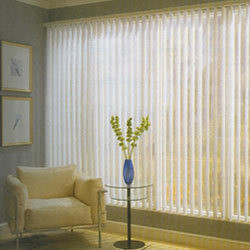
I’ve had a problem recently with our vertical blinds. The damn things keep breaking. Every few weeks, I’ll find a vane lying on the ground after the tab at the top busts loose, sending the 6'-long hunk of plastic flying. I know when it happens because the dog runs and hides under the bed, whining like someone said “veterinarian.”
After nearly four decades together, it’s the first used home my wife and I have owned. The two in Minnesota and the two in Arizona prior to this one were brand new, and we never lived in any of them long enough to worry about replacing things. Don’t even get her started on how many times I’ve made her move.
Anyway, it’s been nonstop renovation ever since. New countertops, new flooring, new appliances and fresh paint everywhere. She even bought some valances to “freshen things up a bit,” but she refuses to replace the blinds themselves. “I’m just not ready yet,” she says.
At the top of each vane sits a rectangular cutout, about 1/8" high, the edge of which fits into a plastic clip that rides within the U-shaped frame above. A tiny strip of plastic running across the end of each cutout is all that holds the vanes in place. It’s no wonder they break so easily.
My previous repair procedure involved cutting the end off of a CTE business card to match the missing strip and then Scotch-taping it in place. That would usually buy me a couple of months. But with literally hundreds of vanes hanging from the dozen or so vertical blinds in This Old House, I was kept pretty busy repairing them.
You’re probably wondering by now what any of this has to do with cutting tools, machining, programming or any of the many other topics covered in this magazine. Wait for it—I’m getting there.
A few weeks ago, after a particularly bad morning when four vanes fell in quick succession (we’ve barely seen the dog since), the little woman suggested that my repair methodology was in need of some continuous improvement. “You’re not doing it right,” she hollered. “You should call a professional.”
She was talking about Joe, the neighborhood handyman.
But since the love of my life remained stalwart in her refusal to purchase new window treatments and since I wasn’t about to hire Joe, I turned to the only alternative possible: Amazon.
Five minutes later, I’d ordered a 15-pack of overpriced, surely Chinese-made Vertical Blind Vane Savers. And because I am a Prime member and tithe $119 each year to the Church of Jeff Bezos, my purchase appeared in the mailbox the next day. Don’t you just love Amazon?
I was skeptical, I admit, and secretly hoped that the clips would be every bit as junky as expected so that I could finally push my beloved into buying new blinds. Boy, was I wrong. These things are beautiful, like metal Michelangelos. Precision as all get-out. Beautifully crafted. They snapped over the ends of the broken vanes in seconds.
I am no tool and die maker but know enough to recognize that the clips were produced on a progressive die, one designed and built by people a heck of a lot smarter than me and with metalworking skills I can only dream about.
My vertical window blinds experience has reinforced an important lesson, one that everyone—especially those outside of the trades—should recognize: Where would we as a society be without manufacturing? There’d be no cars, no airplanes, no surgical procedures or prescription drugs, no takeout pizza and cold beer on a Saturday night, and there’d certainly be no online ordering of replacement parts for worn-out window blinds.
I’ve since repaired or performed preventive maintenance on every set of blinds in the house. At a bit less than 50 cents apiece for each vane, the total job cost me around a hundred bucks, far less than new window treatments.
Of course, I now have to hear the “You should have listened to me to begin with” mantra from the mother of my children, but that’s OK. The dog and I are both much happier.
Related Glossary Terms
- metalworking
metalworking
Any manufacturing process in which metal is processed or machined such that the workpiece is given a new shape. Broadly defined, the term includes processes such as design and layout, heat-treating, material handling and inspection.







